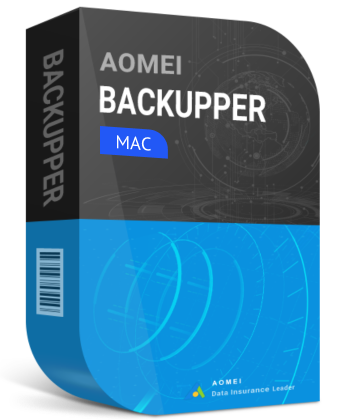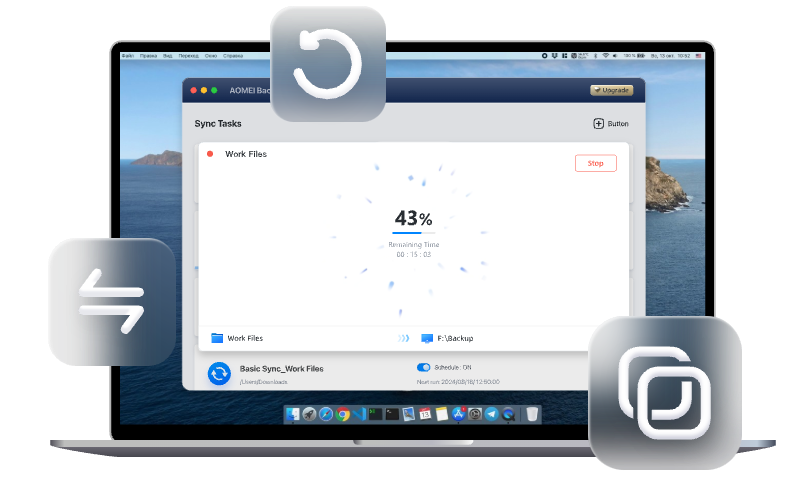Why You Can't Copy Files from Mac to USB and How to Fix It
This article delves into the common problem of being unable to copy files from a Mac to a USB drive. We explore multiple solutions with detailed steps, provide a product introduction for AOMEI Backupper, and offer a comprehensive FAQ section to address related queries.
Cannot Copy to USB Flash Drive
“I'm brand new to Mac Book Pro and have used PC's for years. So this may be a stupid question. Using Finder I can copy/paste files from my flash drive to the Mac, but I cannot copy from my Mac to the flash drive. Why?”
– Apple Community
Introduction to File Transfer Issues from Mac to USB
Encountering difficulties when trying to copy files from a Mac to a USB drive is a common frustration among users. This problem can stem from various causes, ranging from compatibility issues to corrupted files. In this guide, we will explore effective solutions to resolve this issue, ensuring a seamless file transfer process.
Common Causes of File Transfer Issues from Mac to USB
Copying files from a Mac to a USB drive can sometimes be problematic due to a variety of reasons. Here are some common causes of file transfer issues:
📌File System Compatibility: Mac drives often use HFS+ or APFS file systems, which may not be compatible with USB drives formatted in FAT32 or NTFS, causing transfer issues. MacOS can read but not write to NTFS-formatted drives without third-party software, preventing file transfer.
📌USB Drive Issues: Physical damage or corruption of the USB drive can prevent files from being transferred successfully. A lack of free space on the USB drive can halt transfers.
📌File Size Limitations: FAT32-formatted USB drives have a 4GB file size limit, which can cause issues when transferring larger files.
Permission Issues: Files with restrictive permissions on the Mac may not transfer properly to a USB drive. Lack of administrative privileges on the Mac can restrict file transfers.
📌Software Conflicts: Security software on the Mac or the USB drive might interfere with the transfer process. Background processes or applications accessing the files can prevent successful transfers.
Solutions to Fix Cannot Copy File from Mac to USB
Fix 1: Use the File Syncing Tool to Sync File from Mac to USB
If for some reason you can't copy and paste MAC files directly into a USB drive, maybe you can try using third-party file sync software to sync them. AOMEI Backupper Mac offers an impeccable solution for file syncing. AOMEI Backupper is designed with an intuitive interface and powerful features, making it easy to protect your data. The AOMEI Backupper Mac version offers a dependable and efficient solution for syncing, ensuring your important files are always secure.

-
Comprehensive Mac Syncing: Effortlessly sync any files on your Mac to ensure complete data protection.
-
Variety of Sync Options: Choose from Basic Sync, Mirror Sync, or Two-Way Sync to suit your synchronization needs.
-
Multiple Storage Choices: Sync to local storage, cloud drives, NAS devices, external hard drives, USB flash drives, SD cards, and more.
-
Fast and Secure Syncing: Enjoy high-speed synchronization with advanced technology, ensuring your data is encrypted and secure throughout the process.
Step 1: Download and install AOMEI Backupper Mac on your device. Click on "New Task" to initiate the process.
Step 2: Choose your sync type. Generally, Basic Sync is sufficient for transferring files.
Basic Sync: This option copies files from one location to another, ensuring the destination has a copy of the source files without deleting the originals.
Mirror Sync: This method makes the destination an exact replica of the source. It deletes any files in the destination that are not present in the source, maintaining an identical mirror.
Two-Way Sync: This option keeps files updated in both the source and destination. Any changes in either location are reflected in the other, keeping both locations identical.
Step 3: Select your source and destination for the sync. Choose your USB drive as the sync destination.
Step 4: Adjust any schedules or options as needed.
You can schedule the sync to run at your desired frequency: once, hourly, daily, weekly, or monthly. You can also set the start time and choose whether to hibernate or shut down the computer after the sync is complete.
In the Options, users can further customize settings such as including or excluding specific files and folders.
Step 5: Click "Sync" and wait for the process to complete.
Fix 2: Reformat the USB Hard Drive
If your disk is physically connected to your Mac but still won't mount, you might see a message in Finder saying your Mac can't read it because it's not formatted correctly. Fortunately, reformatting the disk is a straightforward process. However, reformatting will erase all the data on the disk. Therefore, if you have important files on the drive, you should first connect them to a computer that can read them and copy the files elsewhere. Once your data is safe, follow these steps to reformat the disk:
1. Open your Applications folder, double-click on the Utilities folder, and then open Disk Utility.
2. In the sidebar, select the drive you want to format and click Mount in the toolbar if it's not already mounted.
3. Click Erase in the toolbar.
4. Choose APFS as the format and enter a name for the disk.
5. Click Erase to start the reformatting process.
After the disk is reformatted, you should be able to copy files to it without any issues.
Fix 3: Check Permissions on the USB Drive
Sometimes, file transfers on Macs are blocked due to permission settings on your USB drive. These settings might prevent you from copying files if they aren’t configured correctly.
To fix this, follow these steps to change the USB drive's permission settings:
1. Connect the USB drive to your Mac.
2. Open Finder and navigate to the USB drive.
3. Press "Command-I" to open the Info window.
4. Scroll to the "Sharing & Permissions" section at the bottom. If your permissions are set to "Read Only," click the option next to your username or "everyone" and choose "Read & Write."
This should allow you to transfer files to the USB drive without any issues.
Fix 4: Check Free Space for USB Drive
If your USB drive lacks enough space, you won’t be able to copy files to it. Here’s how to check the available space:
1. Plug in the USB drive and open Finder.
2. Select the USB drive from the left sidebar.
3. Right-click on the USB drive and choose "Get Info."
4. In the Info window, look for the "Available" space to see if there's enough room for your files.
Ensure there is adequate space to avoid transfer issues.
Fix 5: Check the Connection Between The Mac and The USB
Most modern Macs only support USB-C connections for external drives and USB sticks. Ensure the USB-C cable is firmly connected at both ends. If your drive still doesn’t mount, try using a different cable. For drives without a USB-C interface, use a secure adapter connected to both the drive and your Mac.
FAQs about Cannot Copy File from Mac to USB
Q 1: What should I do if my USB drive is read-only?
A 1: Adjust the drive’s permissions by right-clicking the USB drive in Finder, selecting “Get Info,” and changing the permissions to “Read & Write” under the “Sharing & Permissions” section.
Q 2: How do I repair a USB drive using Disk Utility?
A 2: Open Disk Utility, select your USB drive and click the “First Aid” button. This will scan and repair any issues on the drive, potentially resolving transfer problems.
Q 3: Can I use Terminal to copy files to a USB drive?
A 3: Yes, you can use Terminal commands like cp or rsync to copy files to a USB drive. This can be useful for advanced users who prefer command-line operations.
Practical Tips for Smooth File Transfers
- Regularly Backup Data: Ensure you have regular backups to prevent data loss during transfer issues.
- Use Reliable USB Drives: Invest in high-quality USB drives to reduce the risk of hardware failure.
- Keep Software Updated: Ensure your macOS and any related drivers are up-to-date to avoid compatibility issues.
Conclusion
Addressing the problem of not being able to copy files from a Mac to a USB drive involves understanding the underlying causes and applying appropriate solutions. Whether it’s reformatting the USB drive, adjusting permissions, or repairing the drive using Disk Utility, these steps can help resolve the issue effectively. Additionally, tools like AOMEI Backupper can enhance your data management and protection strategies, ensuring seamless operations between your Mac and USB drives. By following the comprehensive guide provided, you can overcome file transfer obstacles and maintain a smooth workflow.

